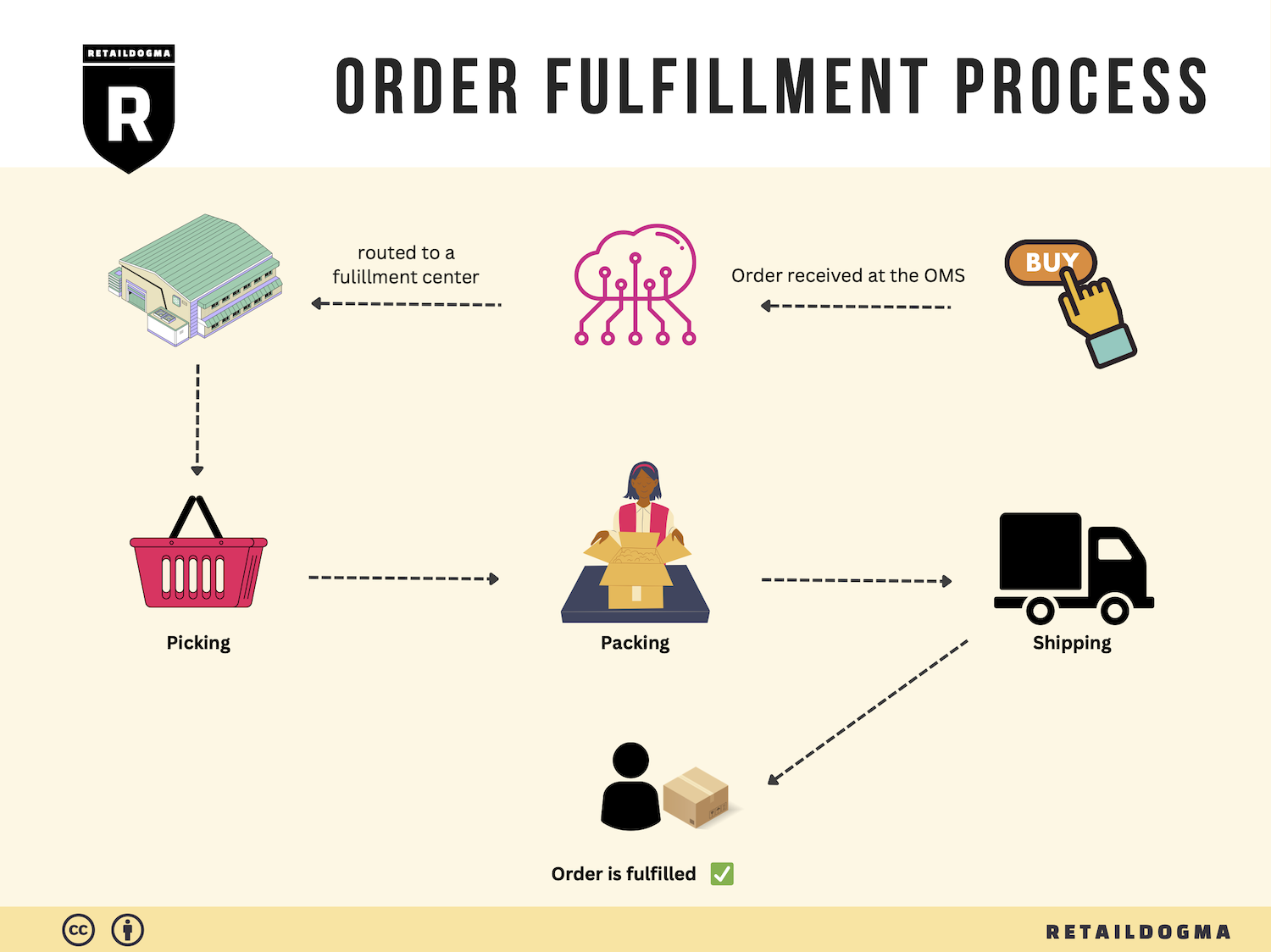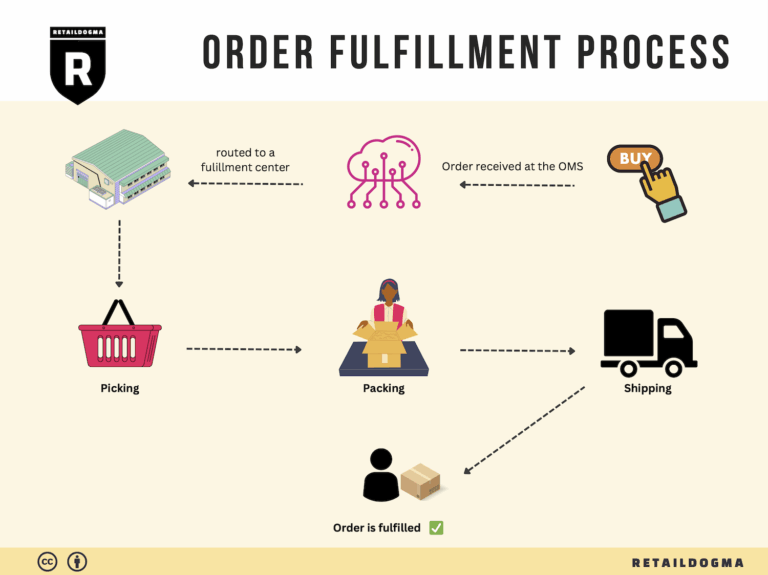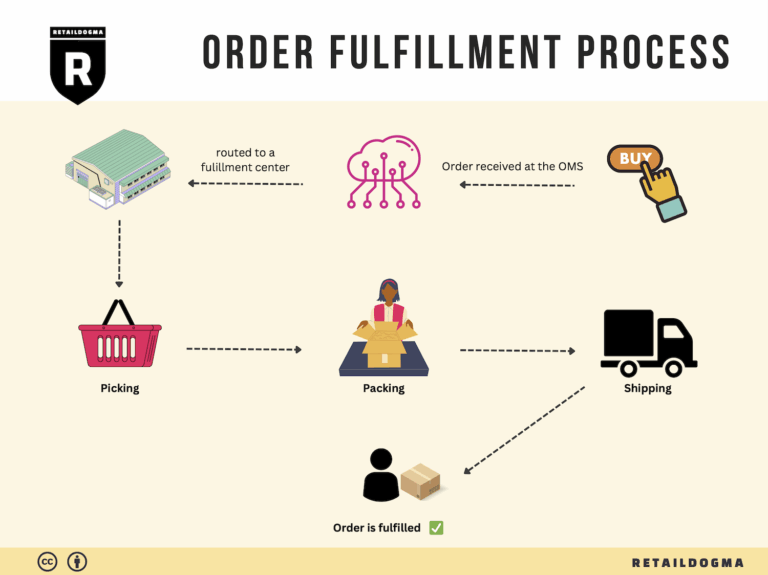Ecommerce Fulfillment Services: The Ultimate Guide (2025)
What is E-commerce Fulfillment? An Introduction for Growing Businesses
Understanding the Fulfillment Process: A Key Challenge for Growing E-commerce Businesses
As e-commerce businesses scale, many owners find themselves overwhelmed by the complexities of packing and shipping orders. The excitement of increasing sales can quickly be overshadowed by the logistical challenges of getting products to customers efficiently and accurately. This is where the importance of e-commerce fulfillment comes into play. Fulfillment is the process of ensuring that a product reaches the customer, encompassing everything from inventory management to packing and shipping.
In this guide, we will demystify e-commerce fulfillment by exploring various fulfillment models, such as Third-Party Logistics (3PL) and Fulfillment by Amazon (FBA). Each model has its unique advantages and challenges, making it crucial for growing businesses to understand which option aligns best with their operational needs and growth objectives.
Core Services of E-commerce Fulfillment
We will delve into the core services associated with fulfillment, including inventory storage, order processing, picking and packing, shipping, and returns management. Understanding these services is essential for identifying which fulfillment partner can best support your business’s specific requirements.
Choosing the Right Fulfillment Partner
Selecting the right fulfillment partner is a pivotal decision that can significantly impact your operational efficiency and customer satisfaction. This guide will provide a framework for evaluating potential partners based on factors such as scalability, technology integration, and customer service.
Pricing Considerations
Cost is often a major concern for growing businesses. We will break down the pricing structures associated with different fulfillment models, helping you to understand the various fees involved and how to budget effectively for fulfillment services.
Empowering Smart Decisions
Ultimately, the goal of this guide is to empower e-commerce businesses to make informed decisions about their logistics strategies. By understanding the nuances of fulfillment, you can streamline operations, enhance customer experiences, and position your business for sustainable growth. Whether you are just starting or looking to optimize your existing fulfillment process, this comprehensive resource will equip you with the knowledge you need to navigate the complexities of e-commerce fulfillment successfully.
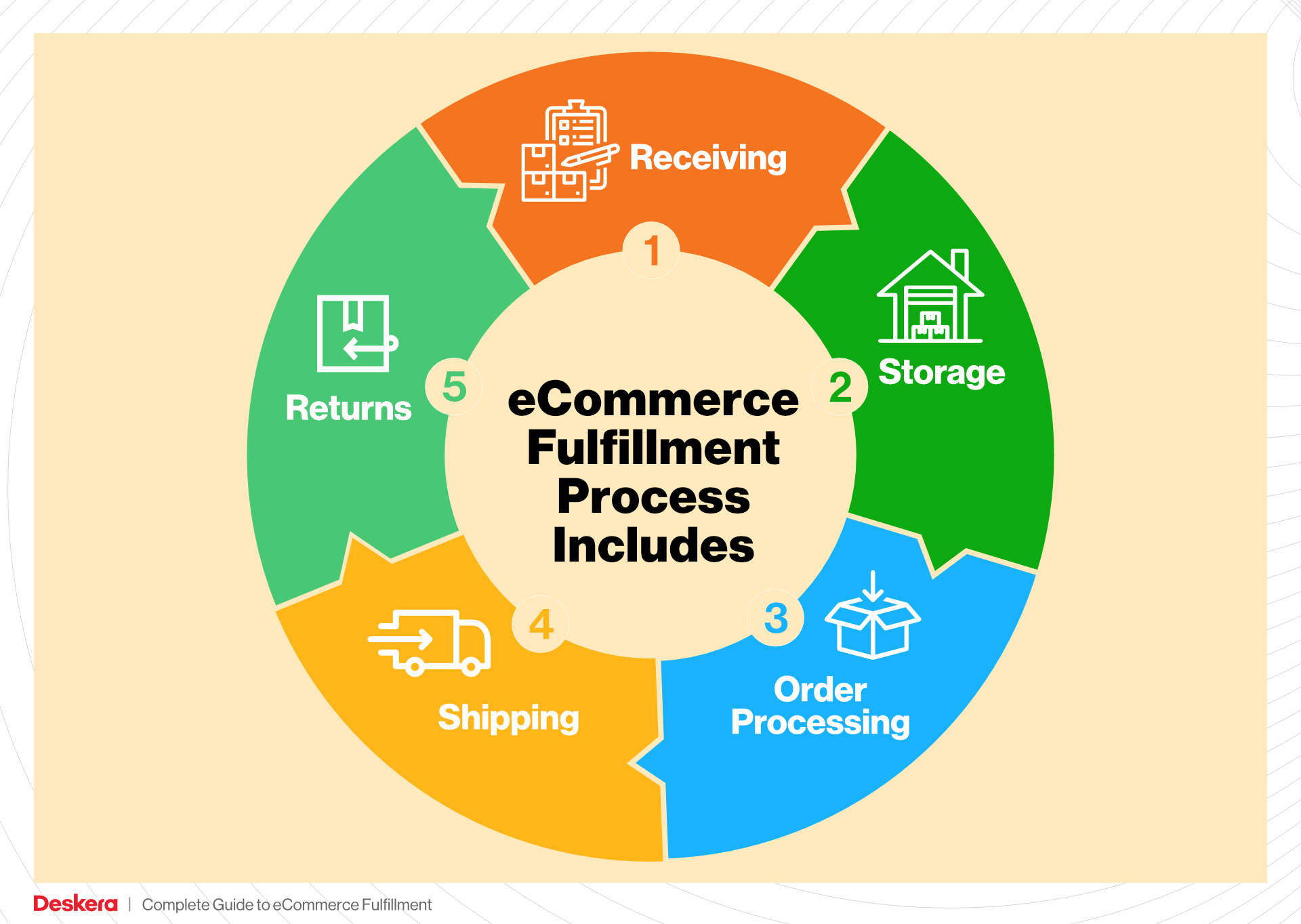
What You’ll Learn In This Guide
- What is E-commerce Fulfillment? An Introduction for Growing Businesses
- The Order Fulfillment Process: From ‘Buy’ Button to Customer’s Door
- Comparing Fulfillment Models: In-House vs. 3PL vs. Dropshipping
- A Deep Dive into Amazon FBA: Pros, Cons, and Who It’s For
- Core Services Offered by Fulfillment Centers
- How to Choose a Fulfillment Partner: A 6-Point Checklist
- Understanding Fulfillment Pricing: A Breakdown of Common Fees
- Frequently Asked Questions (FAQs) about Fulfillment
- Conclusion: Is Outsourcing Fulfillment the Right Move for Your Business?
- Important Disclaimer
The Order Fulfillment Process: From ‘Buy’ Button to Customer’s Door
1. Receiving Inventory
The first step in the order fulfillment process is receiving inventory. When suppliers deliver products to your warehouse, it’s essential to have a systematic approach to check in these goods. This involves verifying that the received items match the purchase orders in terms of quantity, quality, and specifications. Key terms associated with this step include SKU (Stock Keeping Unit), which is a unique identifier for each product variant that helps track inventory levels accurately.
Why is this step important? Effective receiving practices ensure that your inventory records are up-to-date, which is critical for maintaining accurate stock levels and preventing stockouts or overstock situations. A well-organized receiving process also sets the stage for efficient operations in subsequent steps, minimizing delays and errors.
2. Warehouse Storage
Once the inventory has been received and verified, the next step is warehouse storage. This involves organizing and storing products in a manner that facilitates easy access during the picking process. Proper storage strategies include using shelving systems, bins, and clearly labeled locations to optimize space and efficiency.
Key terms to understand here are ABC analysis, which categorizes inventory based on its importance and turnover rates. High-demand items (A) are stored closer to the packing area, while lower-demand items (C) can be placed further away.
The importance of this step cannot be overstated. Efficient warehouse storage reduces the time it takes to locate products during order picking, thereby speeding up the overall fulfillment process. Additionally, a well-organized warehouse minimizes the risk of product damage and loss, ultimately leading to improved customer satisfaction.
3. Order Picking
With inventory stored efficiently, the next step is order picking. This is the process where warehouse staff retrieve products from their storage locations based on customer orders. Order picking can be done using various methods, including single order picking, batch picking, or wave picking, depending on the volume of orders and the layout of the warehouse.
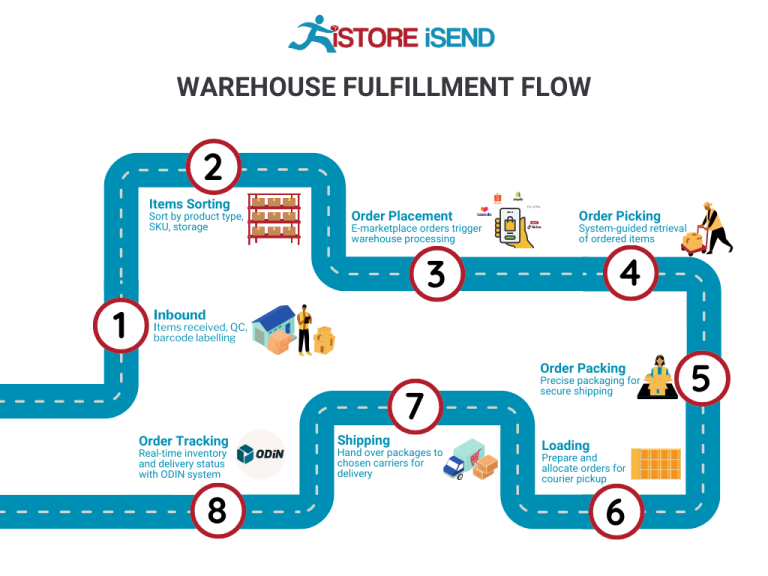
Pick lists are crucial in this step, as they provide detailed information on which items to pick and their respective locations.
This stage is vital because it directly impacts order accuracy and speed. Errors in picking can lead to incorrect shipments, which can harm customer satisfaction and increase return rates. By employing efficient picking strategies and technology, such as barcode scanners or pick-to-light systems, businesses can enhance order accuracy and fulfillment speed.
4. Order Packing
Once the items have been picked, they move to the packing stage. During this step, products are prepared for shipment, which involves selecting appropriate packaging materials, packing the items securely, and labeling the packages with shipping information.
A key term associated with this process is packing slips, which are documents included in the shipment that outline the items contained within the package.
The packing process is crucial for ensuring that products arrive at customers’ doors in good condition. Proper packing reduces the risk of damage during transit and provides customers with a professional unboxing experience. Furthermore, efficient packing processes can streamline operations and reduce shipping costs by optimizing package size and weight.
5. Shipping & Delivery
The final step in the order fulfillment process is shipping and delivery. Once orders are packed, they are handed over to shipping carriers for transportation to the customer’s address. Businesses must choose reliable shipping partners and determine the best shipping methods based on cost, speed, and service quality.
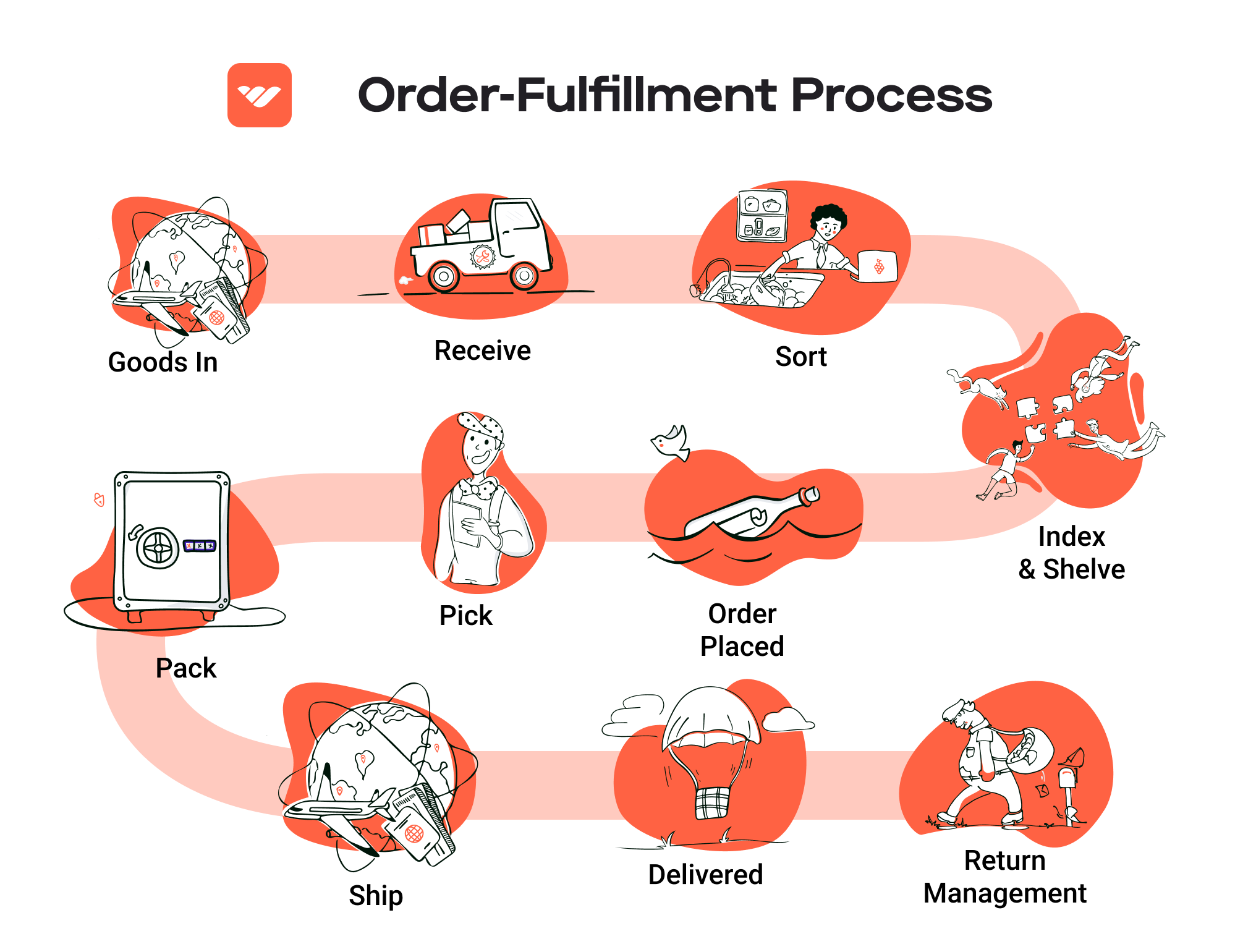
Key terms here include tracking numbers, which allow both the business and the customer to monitor the shipment’s progress until it reaches its destination.
This step is critical because it represents the last interaction a customer has with your brand before receiving their order. Timely and accurate delivery enhances customer satisfaction and builds trust in your brand. Moreover, effective shipping strategies can lead to reduced costs and improved delivery times, ultimately supporting your business’s scalability and growth.
By understanding and optimizing each of these five steps in the order fulfillment process, e-commerce businesses can ensure a seamless transition from the ‘Buy’ button to the customer’s door, enhancing overall operational efficiency and customer satisfaction.
Comparing Fulfillment Models: In-House vs. 3PL vs. Dropshipping
Fulfillment Model Comparison
| Model | Who Handles Inventory | Best For (Business Stage) | Key Advantage | Key Disadvantage |
|---|---|---|---|---|
| In-House Fulfillment | The business itself | Established businesses | Full control over inventory and processes | High overhead costs and resource-intensive |
| Third-Party Logistics (3PL) | An external logistics provider | Scaling businesses | Cost-effective and scalable logistics solutions | Less control over fulfillment processes |
| Dropshipping | Supplier or manufacturer | Startups and small businesses | Minimal investment and inventory risk | Lower profit margins and dependency on suppliers |
In-House Fulfillment
In-house fulfillment refers to a model where a business manages its entire inventory and order processing internally. This approach is most suitable for established businesses that have sufficient resources and a stable customer base. The key advantage of in-house fulfillment is the complete control it provides over the inventory and fulfillment processes, allowing businesses to maintain quality standards, customize packaging, and ensure timely deliveries. This model also enables businesses to have a hands-on approach to inventory management, which can be beneficial for brand identity and customer service.
However, in-house fulfillment comes with significant drawbacks. The overhead costs can be substantial, as businesses must invest in warehousing, staffing, and technology to manage their fulfillment operations. This resource-intensive model can be challenging, especially for smaller businesses or those experiencing rapid growth. Additionally, as order volumes increase, the complexity of managing fulfillment in-house can lead to inefficiencies and potential service issues, making it a less scalable option compared to other models.
Third-Party Logistics (3PL)
Third-party logistics (3PL) involves outsourcing the warehousing and fulfillment processes to an external provider. This model is particularly advantageous for businesses that are scaling and need a cost-effective solution to manage logistics without the burden of maintaining their own warehouse. 3PL providers typically offer a wide range of services, including inventory management, order processing, and shipping, allowing businesses to focus on core activities such as marketing and product development.
The key advantage of using a 3PL is the scalability it offers. As a business grows, it can easily adjust its logistics needs without significant capital investment. This flexibility allows businesses to respond quickly to market changes and customer demands. However, the main disadvantage of 3PL is the reduced control over the fulfillment process. Businesses must rely on the 3PL provider to maintain quality and efficiency, which can lead to inconsistencies if the provider does not meet expectations. Additionally, businesses may face challenges in communication and coordination with their 3PL partner, potentially impacting customer satisfaction.
Dropshipping
Dropshipping is a fulfillment model where the retailer does not hold any inventory but instead transfers customer orders and shipment details to a third-party supplier or manufacturer, who then ships the products directly to the customer. This model is ideal for startups and small businesses with limited capital, as it requires minimal upfront investment and eliminates the risks associated with holding inventory.
The primary advantage of dropshipping is the low barrier to entry. Entrepreneurs can launch their e-commerce businesses with little financial risk, as they are not required to invest in inventory upfront. This model also allows for a wide variety of products to be offered without the need for storage space. However, dropshipping has significant disadvantages, including lower profit margins due to reliance on suppliers and the potential for inventory discrepancies. Additionally, businesses have less control over product quality and shipping times, which can lead to customer dissatisfaction if suppliers do not meet expectations. Moreover, the success of a dropshipping business is heavily dependent on the reliability of the suppliers, making it crucial for entrepreneurs to carefully vet their partners.
Conclusion
When choosing a fulfillment model, e-commerce businesses must consider their current stage, resources, and long-term goals. In-house fulfillment offers control but requires significant investment, while 3PL provides scalability at the cost of some oversight. Dropshipping presents an accessible entry point for new businesses but comes with risks associated with supplier reliability. Each model has its unique advantages and challenges, and the right choice will depend on the specific needs and circumstances of the business. As businesses grow and evolve, they may find it beneficial to reassess their fulfillment strategy to ensure it aligns with their operational goals and customer expectations.
A Deep Dive into Amazon FBA: Pros, Cons, and Who It’s For
Understanding Fulfillment by Amazon (FBA)
Fulfillment by Amazon (FBA) is a service offered by Amazon that allows sellers to store their products in Amazon’s fulfillment centers. Amazon then takes care of storage, packaging, and shipping, while also providing customer service for these orders. This service is designed to help e-commerce businesses scale their operations without the need to manage their own logistics.
How FBA Works
-
Product Listing: Sellers first create a product listing on Amazon, specifying the items they want to sell.
-
Shipping Inventory: Sellers then send their products to Amazon’s fulfillment centers. Amazon provides guidelines on how to prepare and package items to ensure they arrive in good condition.
-
Storage: Once the products are in Amazon’s warehouses, they are available for sale on Amazon’s marketplace. Sellers pay for storage space based on the amount of inventory stored and the duration of storage.
-
Order Fulfillment: When a customer places an order for a product, Amazon takes care of the picking, packing, and shipping. This includes using Amazon’s logistics network to ensure fast delivery.
-
Customer Service: Amazon handles customer inquiries and returns, relieving sellers of the burden of customer service.
-
Payment: After the sale, Amazon deducts fees for FBA services and transfers the remaining funds to the seller’s account.
Pros of Using FBA
1. Prime Eligibility
One of the most significant advantages of FBA is that products become eligible for Amazon Prime. This can dramatically increase visibility and sales, as Prime members often prefer to purchase items with the Prime badge due to the benefits of free two-day shipping.
2. Customer Trust
Products fulfilled by Amazon often benefit from the trust associated with the Amazon brand. Customers are more likely to purchase items that are backed by Amazon’s customer service and return policies, leading to higher conversion rates for sellers.
3. Multi-Channel Fulfillment
FBA is not limited to Amazon.com. Sellers can use FBA to fulfill orders from their own websites or other marketplaces, allowing for a streamlined inventory management system. This is particularly beneficial for brands looking to expand their reach without incurring additional logistics costs.
4. Scalable Operations
FBA allows businesses to scale quickly without the need to invest in their own warehousing or logistics infrastructure. As order volume increases, sellers can send additional inventory to Amazon without worrying about the complexities of order fulfillment.
5. Time Savings
By outsourcing fulfillment to Amazon, sellers can focus on other aspects of their business, such as marketing and product development. This can lead to increased productivity and better overall business performance.
Cons of Using FBA
1. High Fees
FBA can be costly. Sellers incur fees for storage, fulfillment, and additional services, which can eat into profit margins, especially for low-priced items. Understanding the fee structure is essential for maintaining profitability.
2. Strict Inventory Rules
Amazon has stringent inventory management rules that sellers must adhere to. This includes limits on the number of units that can be sent to fulfillment centers and requirements for inventory labeling. Non-compliance can lead to increased fees or even account suspension.
3. Commingling Risks
FBA uses a system called commingling, where products from different sellers are stored in the same inventory pool. This can pose risks, as sellers may receive returns for items they did not sell, leading to potential loss of revenue and brand integrity.
4. Loss of Control
By relying on Amazon for fulfillment, sellers relinquish some control over the customer experience, including packaging and shipping times. If there are issues with fulfillment, sellers may face negative reviews that can impact their overall ratings on the platform.
5. Dependence on Amazon
Using FBA ties sellers closely to Amazon’s ecosystem. Any changes in Amazon’s policies, fee structures, or algorithms can have direct implications on a seller’s business, making it essential to stay informed and adaptable.
Who is FBA Best For?
Fulfillment by Amazon is particularly well-suited for:
- New Sellers: Those new to e-commerce can benefit from FBA’s infrastructure and customer trust without the upfront investment in logistics.
- Scalable Businesses: Businesses looking to scale quickly can leverage FBA’s capabilities to manage increasing order volumes without heavy investments in warehousing or staff.
- Brands with High Demand: Sellers with products that have steady demand and can absorb FBA fees will find the service beneficial for boosting visibility and sales.
- Multi-Channel Sellers: Brands that sell on multiple platforms can streamline their operations using FBA, ensuring efficient order fulfillment across different sales channels.
In conclusion, while Fulfillment by Amazon offers numerous advantages for e-commerce businesses, including scalability and customer trust, it is crucial for sellers to weigh these benefits against the associated costs and risks. Understanding the FBA model and preparing for its challenges can lead to significant growth opportunities for businesses ready to embrace Amazon’s fulfillment capabilities.
Core Services Offered by Fulfillment Centers
Inventory Management & Warehousing
Inventory management and warehousing are foundational services provided by fulfillment centers. This involves the systematic tracking of inventory levels, orders, sales, and deliveries. Fulfillment centers utilize advanced inventory management systems that allow businesses to monitor stock levels in real-time, ensuring that products are available when customers want them.
The primary benefit of effective inventory management is the reduction of stockouts and overstock situations. By keeping accurate records of inventory levels, e-commerce businesses can forecast demand more accurately, enabling them to replenish stock timely and efficiently. This not only improves customer satisfaction through faster order fulfillment but also minimizes carrying costs associated with excess inventory. Furthermore, efficient warehousing practices, such as optimized storage solutions and organized layouts, enhance picking efficiency, thereby speeding up the entire fulfillment process.
Pick and Pack Services
Pick and pack services are critical components of the order fulfillment process. This service involves selecting items from the warehouse (picking) and preparing them for shipment (packing). Fulfillment centers employ skilled personnel and technology to ensure that the correct items are picked and packed securely, reducing the risk of errors that could lead to customer dissatisfaction.
The benefits of effective pick and pack services are multifaceted. First, they significantly reduce the time it takes to fulfill orders. Fast and accurate picking means that customers receive their orders quickly, which is vital in today’s competitive e-commerce landscape. Additionally, well-packaged products reduce the likelihood of damage during transit, lowering the costs associated with returns and replacements. By outsourcing these services, e-commerce businesses can focus on core activities such as marketing and customer engagement while ensuring that logistics are handled professionally.
Kitting and Assembly
Kitting and assembly services involve combining multiple products into a single package or preparing items for final assembly before shipping. This is particularly useful for businesses that sell products that are often bundled together, such as promotional kits or complex items that require assembly before use.
The primary advantage of kitting and assembly services is the enhancement of operational efficiency. By pre-assembling products, fulfillment centers can reduce the time required for order processing and shipping. This service also allows businesses to offer customized product bundles, which can be a significant selling point. Customers appreciate the convenience of receiving a complete package rather than having to purchase items separately. Moreover, kitting can lead to cost savings on shipping, as bundled items can often be shipped as one package, reducing overall shipping fees.
Returns Management (Reverse Logistics)
Returns management, or reverse logistics, is an essential service offered by fulfillment centers that handles the return of products from customers back to the warehouse. This process includes receiving returned items, inspecting them, restocking them if they are in sellable condition, and managing any necessary refunds or exchanges.
The benefits of efficient returns management cannot be overstated. A streamlined return process enhances customer satisfaction, as buyers are more likely to shop with companies that offer hassle-free return policies. Furthermore, effective reverse logistics can help e-commerce businesses recover value from returned items, whether through resale, refurbishment, or recycling. This not only mitigates losses associated with returned products but also contributes to sustainable business practices, which are increasingly important to today’s consumers.
In conclusion, utilizing the core services offered by fulfillment centers enables e-commerce businesses to scale efficiently while providing exceptional customer experiences. By leveraging inventory management, pick and pack services, kitting and assembly, and returns management, businesses can optimize their logistics, reduce operational costs, and ultimately drive sales growth.
How to Choose a Fulfillment Partner: A 6-Point Checklist
Location & Warehouse Network
Importance:
The geographical location of your fulfillment partner’s warehouses is critical to ensuring timely delivery to your customers. A partner with strategically placed warehouses can significantly reduce shipping times and costs, which is essential for maintaining customer satisfaction in e-commerce.
Questions to Ask:
– Where are your warehouses located, and how many do you operate?
– Do you have warehouses near my primary customer base?
– How do you manage inventory across multiple locations?
– What is your average shipping time to major regions?
Technology & Integrations
Importance:
In today’s digital age, the technology used by your fulfillment partner can make or break your logistics operations. A robust technology platform allows for real-time tracking, inventory management, and seamless integration with your e-commerce platform, enhancing operational efficiency and customer experience.
Questions to Ask:
– What technology platform do you use for order processing and inventory management?
– Can your system integrate with my current e-commerce platform (e.g., Shopify, WooCommerce)?
– Do you provide real-time tracking updates for both my team and my customers?
– What reporting tools do you offer to help me analyze fulfillment performance?
Specializations (e.g., Cold Storage, Oversized Items)
Importance:
Different businesses have unique needs based on the types of products they sell. If your products require special handling, such as cold storage for perishable items or specific accommodations for oversized goods, it’s crucial to select a partner with the right capabilities.
Questions to Ask:
– What types of special handling do you provide (e.g., refrigeration, hazardous materials)?
– Can you accommodate oversized items, and what are the limitations?
– Do you have experience in fulfilling similar products to mine?
– What measures do you take to ensure product integrity during storage and shipping?
Scalability & Capacity
Importance:
As your business grows, so will your fulfillment needs. A good fulfillment partner should be able to scale operations without compromising service quality. Understanding their capacity to handle increased order volumes is vital to avoid fulfillment bottlenecks.
Questions to Ask:
– What is your current capacity for handling orders, and how do you manage peak seasons?
– How quickly can you scale operations if my order volume increases?
– Do you have a contingency plan in place for unexpected surges in demand?
– How do you handle seasonal fluctuations in order volume?
Pricing and Contracts
Importance:
Pricing transparency is essential for maintaining profitability. Understanding the cost structure, including any hidden fees, is crucial for budgeting. Additionally, contract terms can affect your flexibility and operational efficiency.
Questions to Ask:
– What is your pricing model (e.g., per order, per item, storage fees)?
– Are there any additional fees (e.g., setup, shipping, returns)?
– What are the terms of the contract, and is there flexibility for renegotiation?
– Can you provide a detailed breakdown of all costs involved in the fulfillment process?
Customer Support & Reviews
Importance:
Reliable customer support can be a lifesaver when issues arise. A partner that provides excellent support can help resolve problems quickly, minimizing disruptions to your business. Additionally, reviews and testimonials can offer insights into the partner’s reliability and service quality.
Questions to Ask:
– What type of customer support do you offer (e.g., phone, email, live chat)?
– What are your support hours, and how quickly can I expect a response?
– Can you provide references or case studies from other clients in my industry?
– How do you handle issues related to order fulfillment, and what is your escalation process?
Conclusion
Choosing the right fulfillment partner is a pivotal decision for your e-commerce business. By following this checklist and asking the right questions, you can make an informed choice that aligns with your operational needs and growth ambitions. A strong partnership can help streamline your logistics, enhance customer satisfaction, and ultimately support your business’s success as you scale.
Understanding Fulfillment Pricing: A Breakdown of Common Fees
Initial Setup Fees
When partnering with a fulfillment center, businesses often encounter initial setup fees. These charges cover the costs associated with establishing your account and integrating your systems with the fulfillment provider’s technology. The setup process may involve configuring your inventory management system, customizing your order processing workflows, and ensuring that your products are accurately represented in the fulfillment center’s database.
Typically, initial setup fees can range from a few hundred to several thousand dollars, depending on the complexity of your operations and the level of integration required. It’s essential to clarify what is included in these fees, as some providers may offer discounted rates or waive them entirely for businesses committing to long-term contracts.
Receiving Fees
Receiving fees are incurred when the fulfillment center accepts and processes your inventory. This fee covers the labor and resources needed to unload, inspect, and enter your products into the warehouse management system. Receiving fees can vary based on several factors, including:
- Volume of Inventory: Larger shipments may incur a lower per-unit cost due to economies of scale.
- Type of Products: Special handling requirements for fragile or oversized items can lead to higher fees.
These fees are typically charged per pallet or per hour of labor required to process the incoming goods. Understanding your product dimensions and characteristics can help you negotiate better terms with your fulfillment provider.
Storage Fees (per pallet/bin)
Storage fees are charged for the space your inventory occupies within the fulfillment center. These fees can be calculated based on several criteria:
- Type of Storage: Rates may differ for pallet storage versus bin storage, with pallet storage generally being more cost-effective for larger items.
- Duration of Storage: Some providers charge monthly fees, while others may implement a tiered pricing structure based on the length of time items remain in storage.
On average, storage fees can range from $10 to $50 per pallet per month, depending on the location and the provider. Monitoring your inventory turnover can help you manage these costs effectively; slow-moving items may incur higher storage fees, prompting the need for inventory optimization strategies.
Pick & Pack Fees (per item/order)
Pick and pack fees are charged for the labor involved in retrieving items from storage, packing them for shipment, and preparing them for delivery. This fee structure can be based on several factors:
- Number of Items: The more items in an order, the higher the pick and pack fee, as it requires additional labor.
- Order Complexity: Special packing requirements, such as custom packaging or kitting, can lead to increased fees.
Pick and pack fees typically range from $1 to $5 per item or order, depending on the fulfillment center’s pricing model. Understanding your average order size and product mix will allow you to estimate these costs accurately and make informed decisions about your fulfillment strategy.
Shipping Fees
Shipping fees are often the most variable component of fulfillment pricing and can significantly impact your overall costs. These fees are influenced by:
- Shipping Method: Standard, expedited, and international shipping options will have different costs associated with them.
- Package Weight and Dimensions: Carriers charge based on the actual weight and dimensional weight of packages, so optimizing your packaging can lead to cost savings.
- Destination: Shipping costs can vary greatly depending on whether the destination is local, national, or international.
To estimate shipping fees, fulfillment centers typically use negotiated rates with carriers based on volume. Businesses should strive to compare shipping rates across different carriers and consider integrating a multi-carrier shipping solution for enhanced flexibility and cost savings.
Conclusion and Tips for Accurate Quotes
When seeking quotes from fulfillment providers, it’s crucial to be as detailed as possible about your business needs. Here are some tips for obtaining accurate quotes:
- Provide Detailed Product Information: Include dimensions, weights, and any special handling requirements for your products to ensure accurate receiving, storage, and shipping costs.
- Estimate Order Volumes: Share your projected order volumes, as this can influence pricing tiers and potential discounts.
- Ask About Hidden Fees: Inquire about any additional charges that might not be listed in the initial quote, such as fees for returns or account management.
- Consider Long-Term Contracts: Many fulfillment centers offer better rates for businesses willing to commit to longer terms, so it’s worth negotiating.
By understanding these common fulfillment pricing models and preparing accordingly, e-commerce businesses can make informed decisions that align with their growth strategies and budgetary constraints.
Frequently Asked Questions (FAQs) about Fulfillment
1. What does “Pending Fulfillment” mean in e-commerce?
Pending Fulfillment indicates that an order has been accepted but is still in the process of being fulfilled. This status typically means that the invoice has not yet been sent, and the picking and packing processes for the items in the order are still ongoing. Customers can expect this status to last between 48-72 hours before the order moves to the next stage.
2. How is “Pending Fulfillment” different from “Awaiting Fulfillment”?
There is no substantial difference between “Pending Fulfillment” and “Awaiting Fulfillment.” Both terms indicate that an order is in the queue for processing and has not yet been dispatched due to incomplete picking and packing.
3. How long does Pending Fulfillment typically take?
Most companies require 48-72 hours to complete the Pending Fulfillment stage. However, this timeframe can vary based on the company’s operational efficiency, order volume, and inventory availability.
4. What happens after an order is in Pending Fulfillment?
Once the order is fully picked and packed, it transitions to a shipping status. Customers will receive an email notification with tracking information once their order has been dispatched.
5. What is a fulfillment center?
A fulfillment center is a specialized warehouse designed to store inventory and manage the logistics of order processing. It handles tasks like receiving inventory, picking and packing orders, and shipping products directly to customers. This is distinct from a traditional warehouse, which may primarily focus on storage without these additional services.
6. How does a fulfillment center differ from a warehouse?
While both fulfill storage functions, a fulfillment center is specifically optimized for order processing and logistics management, whereas a warehouse may focus on inventory storage and may not have the capabilities for picking, packing, and shipping orders directly to customers.
7. What is a 3PL (Third-Party Logistics)?
A 3PL provider offers outsourced logistics services, including transportation, warehousing, and distribution. Businesses often partner with 3PLs to streamline their supply chain operations, reduce costs, and improve delivery times without needing to manage these processes in-house.
8. How much do fulfillment services cost?
The cost of fulfillment services can vary widely based on factors such as order volume, storage space needed, and specific services required (e.g., picking, packing, and shipping). Typically, fees may include storage fees, per-order fulfillment fees, and shipping costs. It’s advisable to obtain quotes from multiple providers to find the best fit for your business needs.
9. What should I do if my order remains in Pending Fulfillment for too long?
If your order remains in Pending Fulfillment beyond the expected timeframe (48-72 hours), it’s recommended to contact the seller’s customer service for updates. They can provide insights into any delays or issues affecting your order’s processing.
10. Can I cancel my order while it’s in Pending Fulfillment?
Cancellation policies can vary by seller. If you wish to cancel an order that is still in Pending Fulfillment, it’s best to reach out to the seller’s customer service as soon as possible. If the order has not yet been processed, they may be able to accommodate your request.
Conclusion: Is Outsourcing Fulfillment the Right Move for Your Business?
Evaluating the Benefits of Outsourcing Fulfillment
As e-commerce businesses strive for growth, the decision to outsource fulfillment can be transformative. By leveraging a fulfillment service, companies can save valuable time and resources. Fulfillment partners handle the complexities of inventory management, order processing, and shipping logistics, allowing business owners to focus on core activities such as marketing and customer engagement. This shift not only enhances operational efficiency but also ensures that orders are processed swiftly, improving customer satisfaction.
Scalability is another significant advantage of outsourcing fulfillment. As sales volumes fluctuate—whether due to seasonal trends or marketing campaigns—fulfillment partners can adjust their services accordingly. This flexibility means that businesses can grow without the burden of managing increased operational demands, thus enabling them to scale up or down with ease while maintaining service quality.
Expertise plays a crucial role in the decision to outsource. Fulfillment centers specialize in logistics and have the experience and technology necessary to optimize the supply chain. They are well-versed in best practices, which can lead to cost savings and improved shipping rates. Furthermore, they often provide access to advanced tracking systems and analytics, empowering businesses with insights that can drive strategic decisions.
However, the key to successfully outsourcing fulfillment lies in selecting the right partner. It is essential to evaluate potential fulfillment services based on their capabilities, technology, and customer service. A partnership that aligns with your business goals will facilitate growth and enhance your operational performance.
To determine if outsourcing fulfillment is the right move for your business, conduct an audit of your current shipping processes. Assess your operational pain points, and identify areas where a fulfillment partner could add value. This strategic step will help you make an informed decision that could propel your business to new heights.
Important Disclaimer
⚠️ Important Disclaimer
The information in this guide is for educational purposes. Fulfillment services, pricing, and platform features change frequently. Always conduct your own due diligence and consult with providers directly before making business decisions.
